| Karangasem
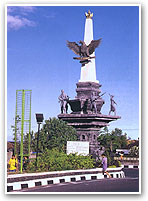 The main
town of the district of Karangasem, Amlapura, was ravaged by
lava during the 1963 eruption of Mount Agung. Most of the
lower area of the town was destroyed, and homeless refugees
were taken into the royal palace, high on the town, for
shelter and food. The main
town of the district of Karangasem, Amlapura, was ravaged by
lava during the 1963 eruption of Mount Agung. Most of the
lower area of the town was destroyed, and homeless refugees
were taken into the royal palace, high on the town, for
shelter and food.
The kingdom of Karangasem, emerged during
the 17th century, at a time when the powers of the
Dewa Agung of Klungkung were at their lowest ebb. During the
next two centuries Karangasem became the most powerful state
in Bali, and Raja extended his power to Lombok at the turn of
the 19th century, where he installed Balinese
princes as rulers of different parts, and named his daughter
as Regent. There followed a period of inglorious history of
inglorious history of corruption, usury and warring in Lombok,
which gave the Dutch the very opportunity they sought to
intervene and add Lombok to their colonial
territories.
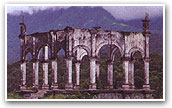 Despite a
dishonorable reputation, the royal family retained their
throne in Karangasem through cooperation with the Dutch Army
in return for favors. The close European connection can be
seen in the architecture of the Puri Kanginan Palace, which
his a strange combination of design from Europe, China and
Bali. The main building, called the "Bale London", has
furniture bearing the Royal Crest of England, Chinese wooden
paneling, and a collection of antiques from Holland, all in a
traditionally styled Balinese pavilion with a large
verandah. Despite a
dishonorable reputation, the royal family retained their
throne in Karangasem through cooperation with the Dutch Army
in return for favors. The close European connection can be
seen in the architecture of the Puri Kanginan Palace, which
his a strange combination of design from Europe, China and
Bali. The main building, called the "Bale London", has
furniture bearing the Royal Crest of England, Chinese wooden
paneling, and a collection of antiques from Holland, all in a
traditionally styled Balinese pavilion with a large
verandah.
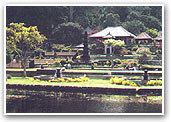 The late
Raja, Anak Agung Anglurah Ketut, took great pleasure as a
young man in creating architectural landmarks, and especially
loved building moats and pools. He designed a fantastic moated
Water Place five kilometers south of Amlapura at the fishing
village of Ujung in 1921, and then 26 years later, in the last
filing, built a rest place at rest place Tirta Gangga, a
series of pools and fountains decorated by strange status. The
water Place has suffered great damage from earthquakes, and
despite many efforts, both local and foreign, to repair it,
has almost crumbled into ruins. Tirta Gangga a little damaged
during the 1963 eruption and 1979 earthquakes, is still in
reasonable repair and has become a popular weekend bathing
spot for the public. The late
Raja, Anak Agung Anglurah Ketut, took great pleasure as a
young man in creating architectural landmarks, and especially
loved building moats and pools. He designed a fantastic moated
Water Place five kilometers south of Amlapura at the fishing
village of Ujung in 1921, and then 26 years later, in the last
filing, built a rest place at rest place Tirta Gangga, a
series of pools and fountains decorated by strange status. The
water Place has suffered great damage from earthquakes, and
despite many efforts, both local and foreign, to repair it,
has almost crumbled into ruins. Tirta Gangga a little damaged
during the 1963 eruption and 1979 earthquakes, is still in
reasonable repair and has become a popular weekend bathing
spot for the public.
The eruption 1963 simultaneously covered
much of the lands of Karangasem in lava and rock, and rendered
the remainder highly fertile once the volcanic ash, rich in
minerals, had finally settled. The region is still highly
cultivated; that land which cannot be leveled and irrigated
for rice farming is plated out in maize and fruit trees.
Papaya, mandarins, durian and bananas grow in great
quantities, and there are plantations of salak, the unusual
"snake-skin" fruit, on the hilly slopes of
Sibetan.
Exploring the
Countryside
Just prior to the bridge leading into the
town of Amlapura, in a valley of solidified lava, is a road
that leads inland to lower slopes of Mount Agung. Joining up
with the Klungkung-Besakih road at Rendang, this forms an
inland route through some of the most delightful scenery of
the easternmost regency. The road winds through rustic little
villages climbing up through the salak plantations of Sebetan
to Selat. A back road branches off from Selat through the
villages of Iseh, which was chosen by the German artist Walter
Spies as a country retreat in 1932. Later, Swiss painter Theo
Meier lived in the same house, which was recently rebuilt and
restored by Florentine-born writer Idana Pucci. The rustic
little village of Iseh commands a magnificent view of rice
field terraces that stretch up towards the
volcano.
Pura
Besakih
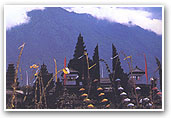 Bali’s
largest and most famous temple, Pura Besakih, is situated high
on the slopes of Mount Agung. Established around about 1007,
it has been regarded as the major temple on the island of
Bali, focal point of the Hindu religion, since the
15th century. Each regency of Bali has its own
sub-temple within the great Besakih complex, and all Balinese
pay homage here. There are 18 separate sanctuaries, all
belonging to the different affiliations and castle groups. The
three major temples are Pura Penataran Agung, once belonging
to the royal family of Klungkung, dedicated to the Supreme God
Sang Hyang Widhi Wasa, Pura Kiduling Kreteg, dedicated to
Brahma, and Pura Batu Medog, dedicated to Wisnu. Bali’s
largest and most famous temple, Pura Besakih, is situated high
on the slopes of Mount Agung. Established around about 1007,
it has been regarded as the major temple on the island of
Bali, focal point of the Hindu religion, since the
15th century. Each regency of Bali has its own
sub-temple within the great Besakih complex, and all Balinese
pay homage here. There are 18 separate sanctuaries, all
belonging to the different affiliations and castle groups. The
three major temples are Pura Penataran Agung, once belonging
to the royal family of Klungkung, dedicated to the Supreme God
Sang Hyang Widhi Wasa, Pura Kiduling Kreteg, dedicated to
Brahma, and Pura Batu Medog, dedicated to Wisnu.
Each of these temples has a regular six
monthly anniversary celebration or odalan, and on the full
moon of the tenth month "kedasa", the entire temple celebrates
a visitation of the gods, "Bhatara Turun Kabeh", and roads are
packed with busloads, bemoloads, and even truckloads of
visiting worshippers bearing offerings from afar. The
ceremonies last for over a week. During this period the temple
is filled with magnificent offerings, and its courtyards are
packed to bursting with throngs of visitors intent on
prayer.
Tenganan
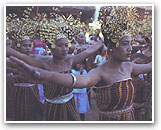 In the
hills of Karangasem, sheltered within a secluded valley, is
the walled village of Tenganan, home of secretive community of
Bali Aga people, so called because they have recited outside
influences for many centuries, preserving they pre-Hindu
customs. The women of village weave a rare double ikat cloth,
the kamben gringsing, with is supposed to have magical powers
to protect the wearer, and is greatly sought after for
cremation ceremonies. The process of weaving this cloth, known
only in this village, can take up to five years for the
completion of one piece. In the
hills of Karangasem, sheltered within a secluded valley, is
the walled village of Tenganan, home of secretive community of
Bali Aga people, so called because they have recited outside
influences for many centuries, preserving they pre-Hindu
customs. The women of village weave a rare double ikat cloth,
the kamben gringsing, with is supposed to have magical powers
to protect the wearer, and is greatly sought after for
cremation ceremonies. The process of weaving this cloth, known
only in this village, can take up to five years for the
completion of one piece.
Unique ceremonial customs are still
practiced in Tenganan, which still maintains an archaic
gamelan selunding, with its iron sound bars, to produce the
melancholy melodies to which the girls dance. Once a year,
during a festival known as usaba sembah, they hold a ritual
tournament in which the men of the village fight each other
with wads of thorned pandanus leaves, the object being to draw
blood in a sacrifice to placate the evil spirits. Despite the
discomfort of the protagonist, this gladiator like competition
is obviously enjoyed by those involved as a chance to display
their bravery and manhood.
Padang
Bai
The main harbor to the east is the tiny
port of Padang Bai, place of transit to Lombok and beyond,
with regular ferries and cargo vessels running service to the
outlying islands. This pearl-shaped bay is also used by
international cruise ships that anchor just out around the
headland, ferrying their passengers in small boats to the pier
that just out into the midst of the bay. Foreign yachts often
anchor in the tranquil waters of this sheltered bay, which is
surrounded by tiny white coves and protected in manuscripts of
Balinese history as residence of the great Hindu Priest Empu
Kuturan, who is remembered for his religious teachings and
reforms of village organization at the beginning of the
11th century. Pura Silayukti, high above the harbor
town, is suppose to have been built on the site of his former
hermitage.
Candi
Dasa
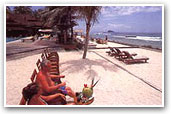 To the
east of Padang Bai, the little beach of Candi Dasa is growing
into a resort area at a rapid rate. For several kilometers
along the gently curving coastline, small hotels and home
stays have sprung of under the coconut palms. The gently
lapping waters and white coral-sand beaches offer an ideal
stopover for visitor touring the island, and the ideal base
for exploring the regency of Karangasem. To the
east of Padang Bai, the little beach of Candi Dasa is growing
into a resort area at a rapid rate. For several kilometers
along the gently curving coastline, small hotels and home
stays have sprung of under the coconut palms. The gently
lapping waters and white coral-sand beaches offer an ideal
stopover for visitor touring the island, and the ideal base
for exploring the regency of Karangasem.
The Coastal Road
to the North
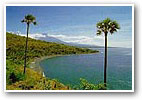 Beyond
the city of Amlapura, on the road which climbs past Tirta
Gangga, it is possible to traverse the coastline all the way
to the northern coast. Passing through dusty little villages
where mandarin orchards thrive in the hot weather, the road
climbs over rocky volcanic outcrops, overlooking serene little
beaches and shady stands of coconut palms. There're some
excellent spots for scuba diving en route, Tulamben in
particular, with its submerged wreck of the S.S.
Liberty. Beyond
the city of Amlapura, on the road which climbs past Tirta
Gangga, it is possible to traverse the coastline all the way
to the northern coast. Passing through dusty little villages
where mandarin orchards thrive in the hot weather, the road
climbs over rocky volcanic outcrops, overlooking serene little
beaches and shady stands of coconut palms. There're some
excellent spots for scuba diving en route, Tulamben in
particular, with its submerged wreck of the S.S.
Liberty.
|

